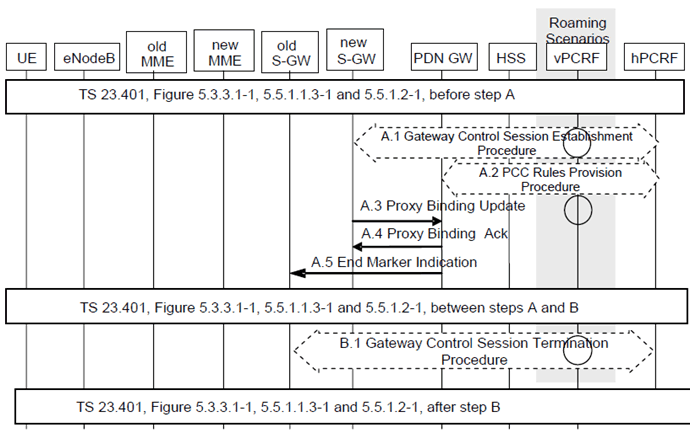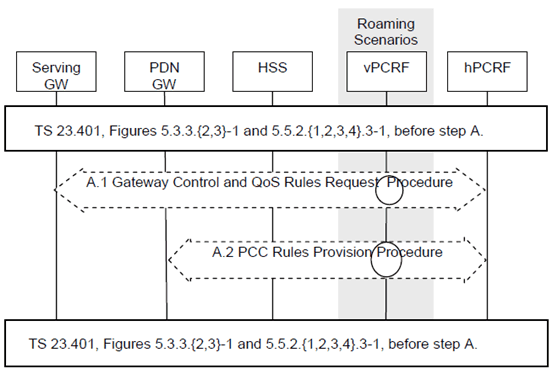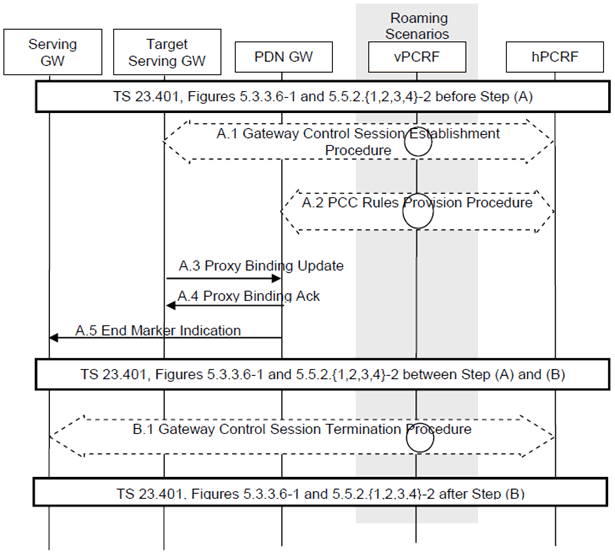Content for TS 23.402 Word version: 18.3.0
0…
4…
4.2…
4.2.2
4.2.3
4.3…
4.4…
4.5…
4.5.7…
4.6…
4.7…
4.7.2…
4.8…
4.8.2a…
4.9…
5…
5.2…
5.4…
5.5
5.6…
5.7…
5.8…
6…
6.2…
6.3
6.4…
6.4.3…
6.5…
6.6…
6.7…
6.8…
6.10…
6.13…
6.15…
7…
7.2…
7.3
7.4…
7.5…
7.6…
7.8…
7.10…
8…
8.2.1.2
8.2.1.3…
8.2.2
8.2.3…
8.2.6…
8.3…
8.4…
8.5…
9…
9.3…
9.4…
10…
13…
16…
16.1.2…
16.1.6…
16.2…
16.2.1a…
16.3…
16.4…
16.7…
16.8…
16.10…
17…
A…
C…
E…
5.7 Handover and Tracking area Update Procedures for PMIP-based S5/S8 Interface
5.7.0 Intra-LTE TAU and Inter-eNodeB Handover without Serving-GW Relocation
5.7.1 Intra-LTE TAU and Inter-eNodeB Handover with Serving-GW Relocation
5.7.2 TAU/RAU or Handover between GERAN A/Gb Mode or UTRAN Iu Mode and E-UTRAN
...
...
5.7 Handover and Tracking area Update Procedures for PMIP-based S5/S8 Interface p. 102
5.7.0 Intra-LTE TAU and Inter-eNodeB Handover without Serving-GW Relocation |R9| p. 102
This clause contains the procedure steps that vary between the GTP and PMIP variant of S5 and S8 for the TAU with MME without Serving-GW change procedure defined in clause 5.3.3.2 of TS 23.401 as well as Inter-eNodeB Handover without Servig GW change procedures as described in clauses 5.5.1.1.2 and 5.5.1.2.2 of TS 23.401.
The procedure is shown in Figure 5.7.2-1. The parameters to be provided to the PGW, as described in TS 23.401, are sent by the Serving-GW via the PCRF to the PGW.
5.7.1 Intra-LTE TAU and Inter-eNodeB Handover with Serving-GW Relocation p. 103
This clause contains the procedure steps that vary between the GTP and PMIP variant of S5 and S8 for the TAU with MME and Serving-GW change procedure defined in clause 5.3.3.1 of TS 23.401 as well as Inter-eNodeB Handover with CN Node Relocation described in clause 5.5.1.2 of TS 23.401.
In case of a Serving-GW relocation, the target Serving-GW must establish a Gateway Control Session with the PCRF to perform policy controlled functions such as Bearer-Binding. The source Serving-GW relinquishes its Gateway Control Session with the PCRF in step B.

Figure 5.7.1-1: Intra-LTE and Inter-eNodeB Handover with Serving-GW Relocation
(⇒ copy of original 3GPP image)
(⇒ copy of original 3GPP image)
This procedure concerns both the non-roaming (S5) as in Figure 4.2.1-1 and roaming case (S8) as in Figure 4.2.1-2. In the roaming case, the vPCRF in the VPLMN forwards messages between the Serving-GW and the hPCRF in the HPLMN. In the case of Local Breakout as in Figure 4.2.3-4, the vPCRF also forwards messages sent between the PDN-GW and the hPCRF. In the non-roaming case, the vPCRF is not involved at all.
The optional interaction steps between the gateways and the PCRF in the procedures in Figure 5.7.1-1 only occur if dynamic policy provisioning is deployed. Otherwise policy may be statically configured with the gateway.
Steps between A.4 and B.1 are described in clauses 5.3.3.1 and 5.5.1 of TS 23.401.
B.1) The old Serving-GW initiates the Gateway Control Session Termination Procedure with the PCRF as specified in TS 23.203. The Serving-GW ceases to perform Bearer Binding and associated policy controlled functions.
Procedures on the MME for X2 and S1 handover are described in clause 5.5 of TS 23.401. If the MME receives a rejection to an S1 interface procedure (e.g. EPS bearer(s) request) from the eNodeB with an indication that an X2/S1 handover is in progress and if during the handover procedure the MME detects that the Serving-GW or/and the MME needs be relocated, the MME rejects any EPS bearer(s) request received since handover procedure started and includes an indication that the request has been temporarily rejected due to handover procedure in progress.
For PMIP based S5/S8, if dynamic PCC is deployed and with Serving-GW relocation, when the Source Serving-GW receives an indication from the MME that the PCRF initiated dedicated bearer procedure was temporarily rejected due to handover, the Source Serving-GW starts a locally configured guard timer. The Source Serving-GW shall re-attempt, up to a pre-configured number of times, at expiry of the guard timer or abort the procedure if it determines that Serving-GW is relocated based on receiving the Delete Session request message from the MME.
A.1)
The Target Serving-GW initiates the Gateway Control Session Establishment Procedure with the PCRF as specified in TS 23.203. As part of the procedure the Serving-GW informs the PCRF of the RAT type, UE Location Information IE and the user CSG information, if available. The PCRF sends information to the Serving-GW enabling bearer binding and other behaviour. The Target Serving-GW checks whether the QoS rules provided by the PCRF aligns with the TFT and Bearer Level QoS of the EPS bearer contexts. If there is a mismatch, the Target Serving-GW initiates appropriate EPS bearer procedures.
A.2)
The PCRF may update the PCC rules at the PDN-GW by initiating the PCC Rules Provision Procedure as specified in TS 23.203. The PCRF also notifies the PDN-GW of the UE Location Information IE and user CSG information (if this has been received from the Serving-GW preceding step A.1).
A.3)
The new Serving-GW performs a PMIPv6 Proxy Binding Update (MN NAI, Lifetime, Access Technology Type option, APN, GRE key for downlink traffic, Additional Parameters) message in order to re-establish the user plane as a result of the Serving-GW relocation. The MN NAI identifies the UE for whom the message is being sent. Within Access Technology Type option an indication for RAT (E-UTRAN) type is set; an indication for handover between MAGs for the same interface is also set. If multiple PDN connections for the given APN are supported by the Serving-GW then the APN and the EPS bearer identity of the default bearer disambiguates which PDN connection this message refers to, otherwise the APN itself identifies the PDN connection of the UE. The additional parameters may include protocol configuration options and other information.
A.4)
The PDN-GW acknowledges the Binding Update by sending a Proxy Binding Ack (MN NAI, Lifetime, UE Address Info, GRE key for uplink traffic, Charging ID, Additional Parameters) message to the Serving-GW. If the EPS bearer identity is included in the Proxy Binding Update, the PDN-GW shall acknowledge if multiple PDN connections to the given APN are supported. A PMIP tunnel is established at this point between the PDN-GW and the Serving-GW. The UE Address Info includes one or more IP addresses. The Additional Parameters may contain protocol configuration options and other information. The Charging Id provided is the Charging Id previously assigned to the PDN connection.
A.5)
If the Serving-GW is relocated, the PDN-GW shall send End Marker Indication message to the source SGW immediately after switching the path. If the source Serving-GW has downlink user plane established, the source Serving-GW shall send one or more "end marker" packets to the source eNodeB immediately after receiving this indication in order to assist the reordering function in the target eNodeB. Otherwise the souce Serving-GW shall ignore the message and shall not send Downlink Data Notification.
5.7.2 TAU/RAU or Handover between GERAN A/Gb Mode or UTRAN Iu Mode and E-UTRAN p. 104
In case of inter-RAT TAU/RAU or handovers, the Serving-GW may or may not be relocated. The PMIP based S5/S8 variants procedure steps for inter-RAT TAU/RAU or handover without Serving-GW relocation are shown in Figure 5.7.2-1 and those corresponding to a change of Serving-GW are shown in Figure 5.7.2-2.
The procedures in this clause correspond to the following Figures in TS 23.401:
- Figure 5.3.3.2-1: [UTRAN Iu mode to E-UTRAN] Tracking Area Update.
- Figure 5.3.3.3-1: E-UTRAN to UTRAN/GERAN RA Update.
- Figure 5.3.3.6-1: E-UTRAN to GERAN A/Gb mode Routeing Area Update.
- Figure 5.5.2.1.3-1: E-UTRAN to UTRAN Iu mode Inter RAT HO, execution phase.
- Figure 5.5.2.2.3-1: UTRAN Iu mode to E-UTRAN Inter RAT HO, execution phase.
- Figure 5.5.2.3.3-1: E-UTRAN to GERAN A/Gb mode Inter RAT HO, execution phase.
- Figure 5.5.2.4.3-1: GERAN A/Gb mode to E-UTRAN Inter RAT HO, execution phase.

Figure 5.7.2-1: Inter-RAT TAU/RAU or Handover without Serving-GW relocation
(⇒ copy of original 3GPP image)
(⇒ copy of original 3GPP image)
This procedure applies to the Non-Roaming (Figure 4.2.1-1), Roaming (Figure 4.2.1-2) and Local Breakout (Figure 4.2.3-4) cases. For the Roaming and Local Breakout cases, the vPCRF forwards messages between the Serving-GW and the hPCRF. In the Local Breakout case, the vPCRF forwards messages between the PDN-GW and the hPCRF.
The optional interaction steps between the gateways and the PCRF in the procedures in Figure 5.7.2-1 only occur if dynamic policy provisioning is deployed. Otherwise policy may be statically configured with the gateway.
A.1)
If dynamic PCC is deployed and during the handover with MME relocation without serving GW relocation, when the Serving-GW receives an indication from the MME that the PCRF initiated dedicated bearer procedure was temporarily rejected due to handover, the Serving-GW starts a locally configured guard timer. The Serving-GW shall re-attempt, up to a pre-configured number of times, when it either detects that the handover is completed or failed using message reception or at expiry of the guard timer.
The following procedure describes inter-RAT TAU/RAU or Handover in the case of Serving Gateway relocation for PMIP-based S5/S8.
The Serving-GW informs the PCRF about the change of RAT type and UE Location Information IE and user CSG information (if this has been received from the MME preceding step A) by initiating the Gateway Control and QoS Policy Rules Request Procedure as specified in TS 23.203.
A.2)
The PCRF updates the PCC rules at the PDN-GW by initiating the PCC Rules Provision Procedure as specified in TS 23.203 if the PCC rules have changed based on the RAT type reported by the Serving-GW in step A.1. Further, the hPCRF notifies the PDN-GW of the change in RAT and the UE Location Information IE and user CSG information (if this has been received from the Serving-GW preceding step A.1).
Step A.2 may be initiated before A.1 completes.

Figure 5.7.2-2: Inter-RAT TAU/RAU or Handover with Serving-GW Relocation
(⇒ copy of original 3GPP image)
(⇒ copy of original 3GPP image)
This procedure concerns both the non-roaming (S5) as in Figure 4.2.1-1 and roaming case (S8) as in Figure 4.2.1-2. In the roaming case, the vPCRF in the VPLMN forwards messages between the Serving-GW and the hPCRF in the HPLMN. In the case of Local Breakout as in Figure 4.2.3-4, the vPCRF forwards messages sent between the PDN-GW and the hPCRF as well. In the non-roaming case, the vPCRF is not involved at all.
If dynamic policy provisioning is not deployed, the optional steps in the procedure are not applied.
Steps between A.4 and B.1 are described in the clauses of TS 23.401, containing the figures referenced in Figure 5.7.2-1 above.
A.1)
The Target Serving Gateway initiates a Gateway Control Session Establishment Procedure with the PCRF, as specified in TS 23.203 and informs the PCRF of the new RAT type, UE Location Information IE and user CSG information (if this has been received from the MME preceding step A). The Target Serving-GW checks whether the QoS rules provided by the PCRF aligns with the TFT and Bearer Level QoS of the EPS bearer contexts. If there is a mismatch, the Target Serving-GW initiates appropriate EPS bearer procedures.
A.2)
The PCRF sends an updated policy to the PDN-GW by initiating the Policy and Charging Rules Provision Procedure as specified in TS 23.203. This contains any effected PCC rules and Event Triggers resulting from the preceding step that may require enforcement or event reporting to be performed by the PDN-GW. The UE Location Information IE and user CSG information are also sent to the PDN-GW from the PCRF (if this has been received from the Serving-GW preceding step A.1).
A.3)
The Target Serving-GW sends a Proxy Binding Update (MN NAI, Lifetime, Access Technology Type, APN, GRE key for downlink traffic, Additional Parameters) message in order to re-establish the user plane as a result of the Serving-GW relocation. The MN NAI identifies the UE for whom the message is being sent. Access Technology Type is set to indicate 3GPP access to EPS; an indication for handover between MAGs for the same interface is also set. If multiple PDN connections for the given APN are supported by the Serving-GW then the APN and the EPS bearer identity of the default bearer disambiguates which PDN connection this message refers to, otherwise the APN itself identifies the PDN connection of the UE. The additional parameters may include protocol configuration options and other information.
A.4)
The PDN-GW acknowledges the Binding Update by sending a Proxy Binding Ack (MN NAI, Lifetime, UE Address Info, GRE key for uplink traffic, Charging ID, Additional Parameters) message to the Target Serving-GW. If the EPS bearer identity is included in the Proxy Binding Update the PDN-GW shall acknowledge if multiple PDN connections to the given APN are supported. A PMIP tunnel is established at this point between the PDN-GW and the Target Serving-GW. The UE Address Info includes one or more IP addresses. The Additional Parameters may contain protocol configuration options and other information. The Charging Id provided is the Charging Id previously assigned to the PDN connection.
A.5)
If the Serving-GW is relocated, the PDN-GW shall send End Marker Indication message to the source SGW immediately after switching the path. If the source Serving-GW has downlink user plane established, the source Serving-GW shall send one or more "end marker" packets to the source eNodeB or source S4 SGSN immediately after receiving this indication. Otherwise, the source Serving-GW shall ignore the message and shall not send Downlink Data Notification.